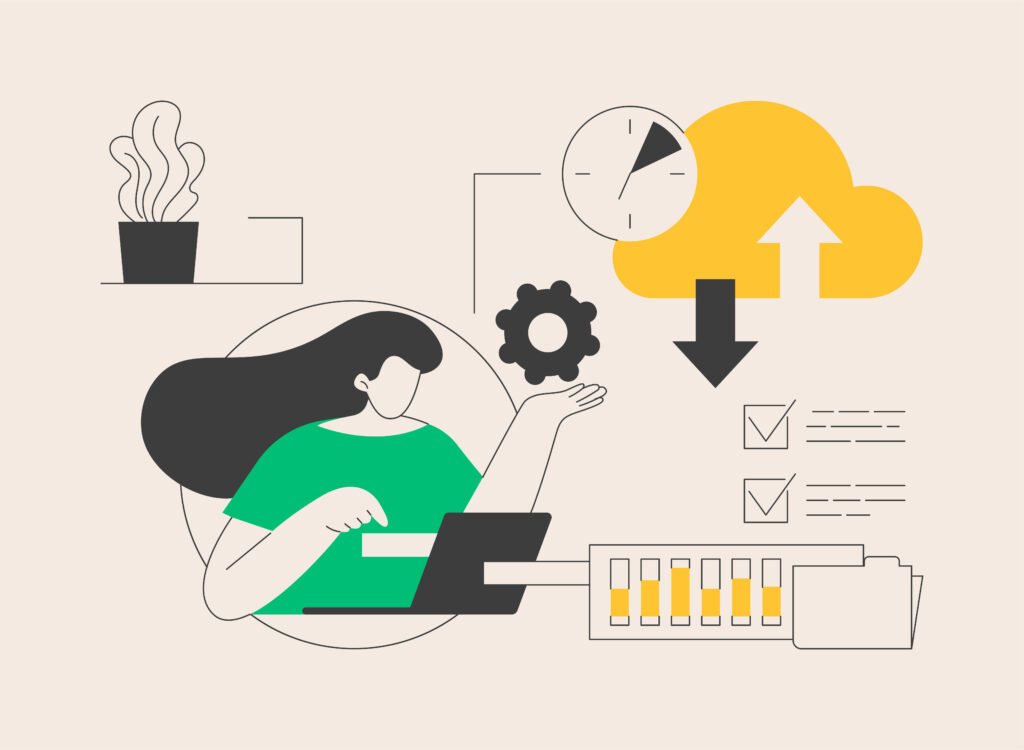Web Portals: Key Facts and Popular Types of Portals
24 Jul 2022
Igor Kelly

Statista says nearly two-thirds of the planet’s population are internet users. An average person spends 395 minutes online (6 hours 35 minutes) daily. You don’t have to look around to learn the significance of online shopping. The same goes for businesses. The importance of having an online presence cannot be overlooked. After discovering a significant online presence, 45% of customers will visit a company’s brick-and-mortar store.
In this regard, web portals have become essential for organizations and individuals. While the first ones create them as an opportunity to attract new clientele, later ones find information, services, and applications and choose the best one from a variety. In this article, we’ll have an in-depth discussion, from learning about types of portals to discovering their crucial role in improving user experiences and making operations more efficient.
Key Facts about Web Portals
Web portals, also known as online or internet portals, are products of custom web development that gather information from different sources and present it in one place for users and may require authentication. Through authentication, web portals provide users with relevant and personalized information, resources, and services.
What sets web portals apart from websites is that they are more customized to particular users. They are designed to attract a specific audience, control user functionality on the page, integrate multiple sources to provide uniform information, and include user management and permission features.
Web portals are web-based systems supporting key organizational processes, including secure access to critical data and enabling short- and long-term workflows. They make it easier for organizations to disperse information to relevant parties without relying on physical mail or emails, which often have strict attachment limits.
Benefits and Challenges
Web portals offer numerous advantages, but they are one fixture for all. Like any other software, it may come with specific challenges. We at Lightpoint prepared a list of benefits and drawbacks for you to be aware of to take a decision.
Advantages of Web Portals
- Streamlined Access to Resources. Portals act as a central hub for accessing different resources, eliminating the need to navigate numerous websites. This is especially valuable for companies with extensive content and services, as it streamlines the user experience.
- Improvements in User Engagement and Satisfaction. Offering personalized content and services can bring user engagement and appreciation through web portals. Users are more likely to return to a portal that recognizes their preferences and delivers relevant information.
- Improved Data Management and Analytics. Portals make it easier to manage data by combining different data sources and providing analysis tools. This allows organizations to gain valuable insights into user behavior, content performance, and operational efficiency, supporting data-driven decision-making.
- Cost Efficiency. Over time, web portals can lead to cost savings by automating processes, reducing the need for manual intervention, and consolidating resources into a single platform. This efficiency can offset the initial high development costs.
- Scalability. Web portals are designed to be scalable, accommodating growing amounts of data and increasing numbers of users without compromising performance. This makes them suitable for businesses looking to expand their digital presence.
Common Challenges
- Security and Privacy Concerns. Protecting user data and ensuring privacy require robust security measures. Web portals are often targets for cyberattacks, necessitating constant vigilance and updates to security protocols.
- High Development and Maintenance Costs. Building and maintaining a web portal can necessitate significant investment in technology and resources. The costs include initial development, ongoing maintenance, updates, and potential customization to meet evolving needs.
- Complexity in Integration and Customization. Integrating different systems and tailoring the portal to address particular requirements can be challenging and time-intensive. It demands meticulous planning and implementation to guarantee smooth compatibility among diverse software and databases.
- User Adoption and Training. For a web portal to be effective, users must be willing and able to use it. This frequently requires training and continuous support, mainly if the portal includes complex features and functionalities.
- Performance Issues. As web portals grow and more users access them, performance can become an issue. Ensuring that the portal remains fast and responsive requires ongoing optimization and sometimes significant infrastructure investments.
Popular Types of Web Portals
Different portals can be classified according to the target audience they are meant for and how they operate. Let’s have a look at some popular types of web portals below.
B2B Portals
B2B (Business to Business) portals are developed to make communication between business organizations efficient. They encompass to a larger extent product or service descriptions and specifications, allow order management and processing. As well as, they might have RFQ (Request for Quotation) and RFP (Request for Proposal) functionality for the procurement process.
B2B portals are often integrated with ERP and CRM systems to ensure that business processes run in parallel with each other, enabling real-time updates for improved efficiency.

B2C Portals
B2C (Business-to-Consumer) portals are aimed to facilitate direct trade between companies and individual consumers. These portals have detailed product listings with high-quality pictures, clear descriptions, and customer reviews to help consumers make intelligent buying choices.
In-built AI and ML algorithms help to offer personalized product suggestions, special deals, and promotions based on preferences, enhancing users’ shopping experience. For secure checkout, there are different payment methods provided.
Another important functionality in B2C portals is order management which includes placing orders, tracking, shipping choices, and delivery status notifications. To help bring in and keep customers, B2C portals allow the implementation of various marketing strategies, such as email campaigns, loyalty programs, targeted ads, and social media campaigns. Some famous examples of B2C portals are Amazon, eBay, and Walmart.
Vendor Portals
Vendor portals help companies, and their suppliers communicate and work together efficiently. Key features include suppliers sign up, upload documents, and make sure they are following the workflow rules. Vendor portals allow creating Vendors can submit invoices electronically and keep an eye on the status of their payments. This reduces the amount of administrative work needed and ensures payments are made on time.
Vendor portals often include performance monitoring tools, such as vendor scorecards, feedback mechanisms, and analytics, to help companies evaluate supplier performance and comply with high-quality standards.
Vendor portals Integration with ERP systems ensure real-time data exchange and updates on inventory levels, order statuses, and financial transactions. Secure communication features, including messaging, document sharing, and collaboration tools, support transparent and efficient communication between companies and vendors.
Data-driven decision-making is based on analytics and reporting tools that offer valuable insights into procurement metrics, cost savings, and supply chain performance.
Self-service Portals
Self-service portals facilitate users’ account management and information discovery. These portals come with helpful guides, FAQs, and a ticketing system for reporting and tracking issues. Users can also update their personal information, manage subscriptions, and personalize their experience.
Self-service portals have dashboards that provide personalized overviews of user interactions and activities, including order status, support tickets, and account settings. This facilitates easy access to information and builds community engagement through forums, creating a collaborative environment.
Self-service portals often incorporate analytics tools that offer insights into portal usage, trends, and feedback, enabling continual improvements for users.
Industry Related Portals
Different industries leverage different types of portals to address specific needs and challenges of the market. We can divide them into the following types:
E-commerce Portals
E-commerce portals make shopping easy, extending the geography of reaching customers and allowing people to shop anytime from anywhere. These portals have lots of products with detailed descriptions, good pictures, and customer reviews to help buyers decide what to purchase. There are also filters that help consumers to find the products they want more quickly.
Built-in secure payment gateways allow customers to pay using various methods, such as credit cards, digital wallets, and other online means. They can also track their orders, see shipping details, and get delivery notifications.
E-commerce businesses can use marketing tools like discounts, promotions, and personalized recommendations to win over and retain customers. E-commerce portals also provide customer support features in the form of live chat, help centers, and FAQs to quickly answer questions and improve the overall shopping experience.
Healthcare Portals
Patients, providers and administrators generally turn to healthcare portals to get medical data and services in the shortest possible time. Healthcare portals might have various functionalities such as EHR management, appointment scheduling, and communication tools.
Healthcare portals facilitate functionalities such as viewing medical records, managing prescriptions, booking appointments, and direct messaging with healthcare professionals.
Electronic health record (EHR) management is beneficial to patients by enabling them to view their records, test results, and therapeutic processes.
Appointment registration allows the patient to make an appointment or even change or cancel the current appointment through the Internet, hence making work easier for healthcare providers. Direct messaging feature enables patients or any person who needs a healthcare professional to message him/her with privacy and gives the option of getting an instant response.
eLearning Portals
eLearning portals are all-in-one platforms for teaching and learning online. They have lists of courses with detailed information and ways to sign up for many different subjects as well as tools for learning like quizzes, homework, and discussion boards, that help students learn and take part. They also incorporate content management systems that help teachers put up and organize lessons so that students can quickly get to them.
eLearning portals help track student progress, manage grades, and generate performance reports as well as provide communication tools like messaging and video conferencing that make interacting easier for students and instructors.
Employee Portals
Employee portals make it easier for employees to communicate, get work done, and stay connected with the company. These portals have dashboards that give employees personalized access to important company news, policies, and announcements. They also have self-service tools so employees can handle their personal information, benefits, payroll, and time-off requests.
Employee portals provide tools such as messaging, document sharing, and project management systems to improve communication across different parts of the company.
Through training and development modules, employees can access online courses, skill assessments, and professional development resources, supporting continuous learning and career growth. Performance management tools help employees and managers set goals, conduct evaluations, and track progress, creating a culture of accountability and achievement.
Fintech Portals
Fintech portals offer a variety of financial services and tools to manage finances, review account balances and transaction histories. They also allow for secure online transactions, bill payments, and fund transfers.
Some fintech portals provide investment management tools that give access to investment portfolios, market analysis, and trading platforms, helping to make well-informed investment decisions.
Budgeting and financial planning tools allow users to track expenses, set financial goals, and create personalized budgets.

Tech Stack for Web Portal Development
Choosing the right tech stack for web portal development involves assessing project requirements, team skills, scalability needs, security considerations, and budget constraints. It’s crucial to prioritize technologies that align with your team’s expertise while also supporting future growth and integration with existing systems.
In portal development services, front-end and back-end technologies come together.
Front-end development is centered around the user interface and user experience. Essential technologies may encompass:
- HTML/CSS. The backbone of web page structure and styling.
- JavaScript. Enables interactive and dynamic features.
- Frameworks. Libraries like React, Angular, and Vue.js enhance development efficiency and performance.
Back-end development deals with server-side operations, databases, and application logic. Key technologies include:
- Programming Languages. Python, Java, PHP, and Node.js are popular choices.
- Databases. SQL databases like MySQL and PostgreSQL, and NoSQL databases like MongoDB.
- Frameworks. Django, Spring, Laravel, and Express.js support efficient back-end development.
Conclusion
Web portals are a simple way to streamline the interaction between your business and customers. Web portals can be equipped with more sophisticated features and improved user experiences. They are becoming more integral to various industries, driving efficiency, engagement, and innovation. Whether you’re a business looking to enhance B2B interactions, an educational institution aiming to support online learning, or a healthcare provider seeking to improve patient care, web portals are a valuable solution. Lightpoint Global takes over the development of custom web portals for you to facilitate and automate the workflows.
Contact us for further information or to discuss what Lightpoint Global has to offer to benefit your business.